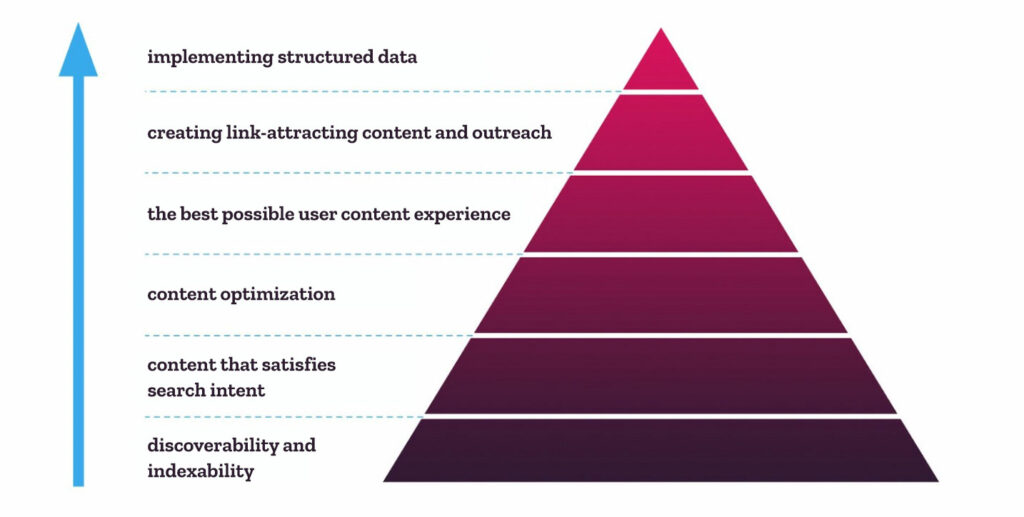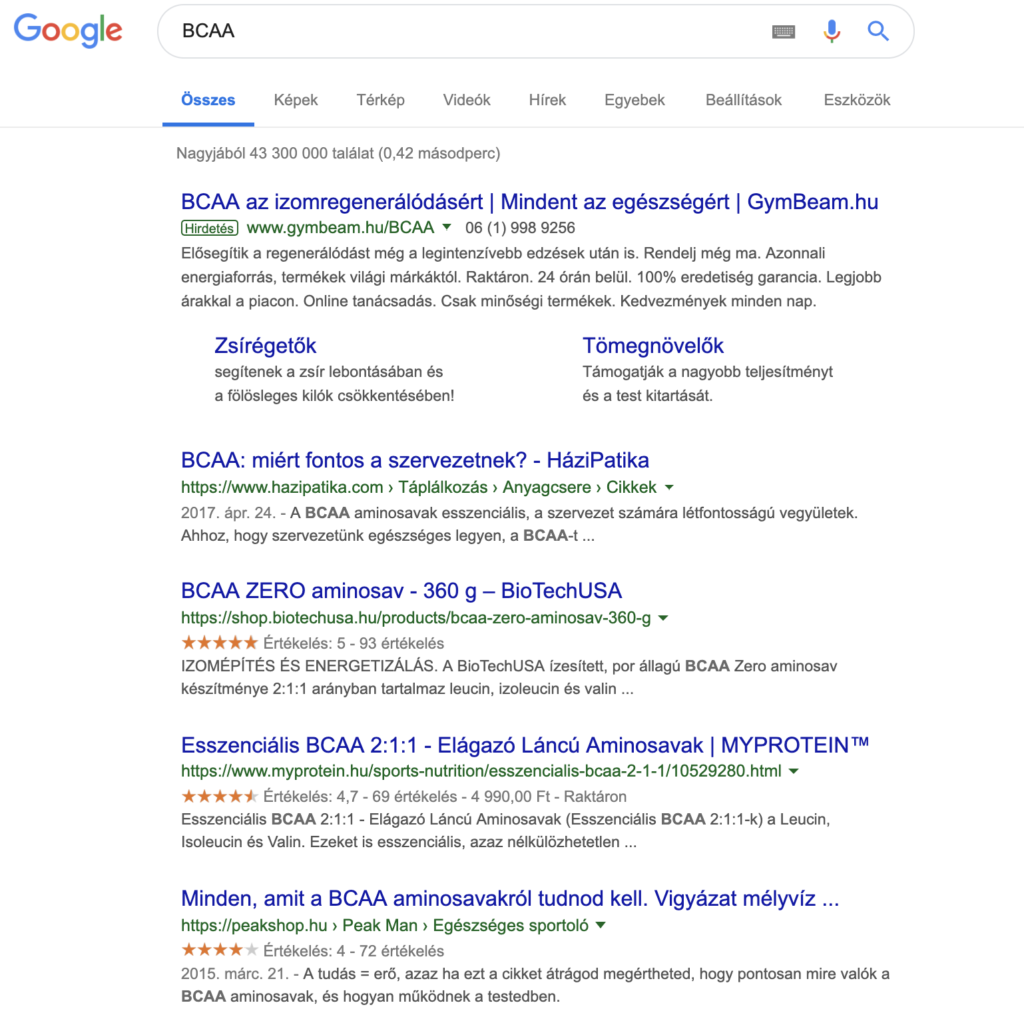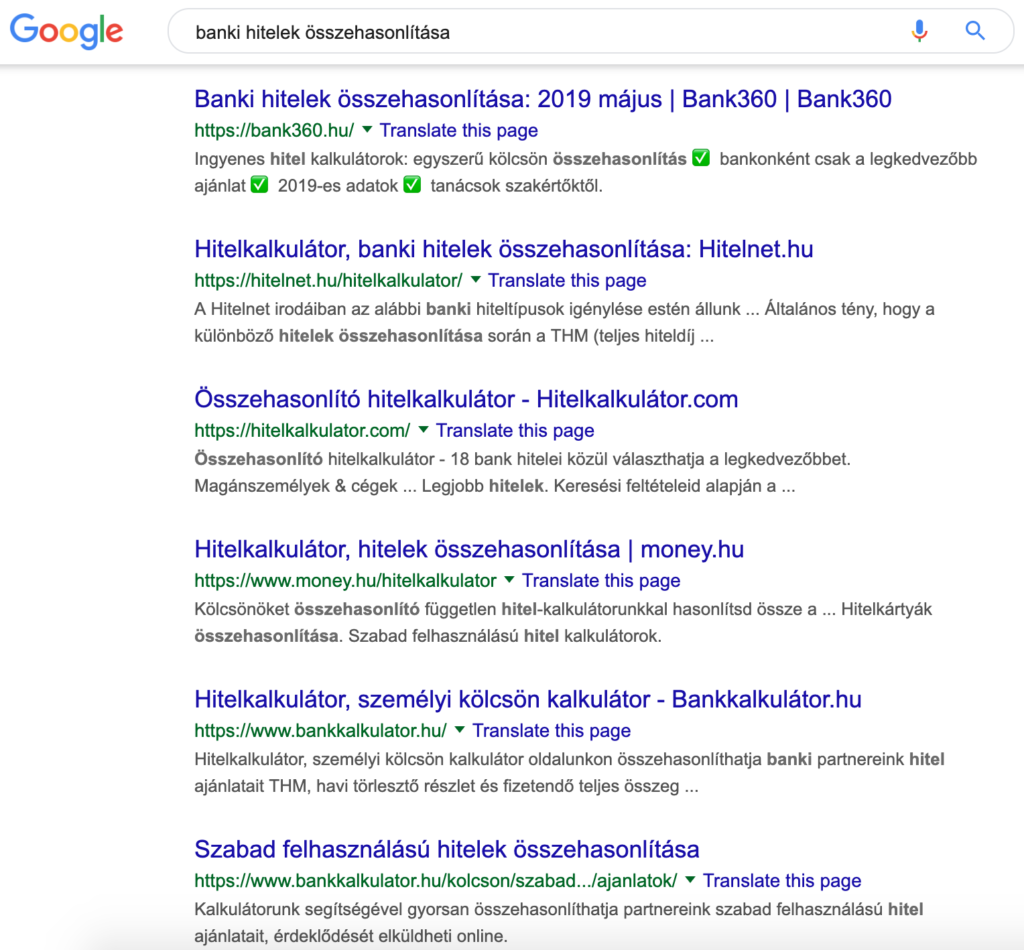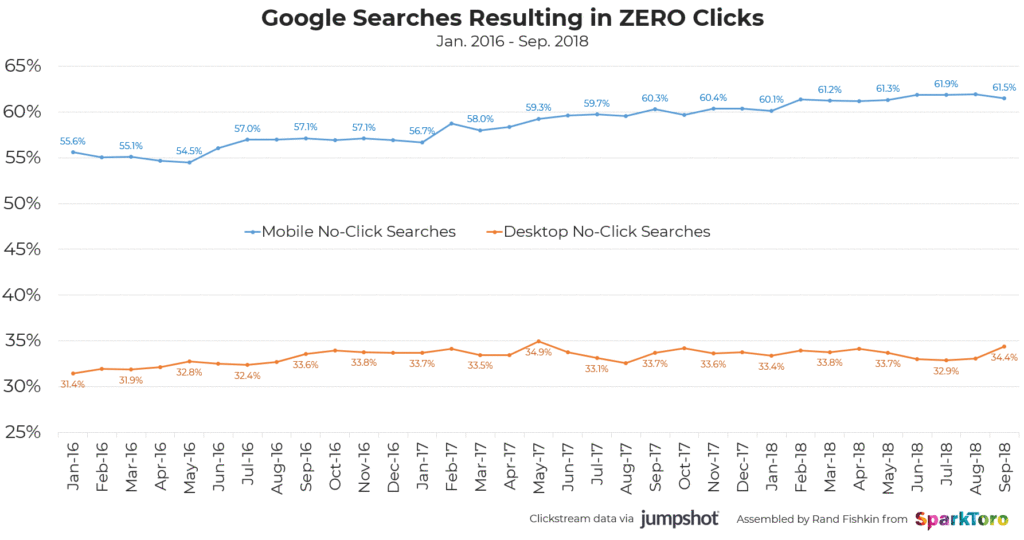Pretty much everyone wants to drive organic traffic to their website. However, few know how to do it. In this article, we show the way from an SEO strategy point of view.
The Elements of an SEO Strategy
Previously we wrote about how you can incorporate SEO into your marketing strategy. The next move is to create an actual SEO strategy.
At a tactical level, SEO can be divided into three main areas:
- technical SEO,
- content-related SEO,
- off-page SEO.
Maslow’s hierarchy of needs is a great base for your strategy. First, you should focus on fundamental needs: a website should be able to appear in Google, then you can get down to developments to increase competitiveness.
To put it simply, first you should appear in Google, then start putting work into making your site more visible.
That’s the purpose of a SEO strategy: to drive as much organic, unpaid traffic from Google to the site as possible, and to increase the visibility of the company in the search engine.
You can achieve your strategic goals by adapting the elements, which are partially built upon each other, as follows:

To reach your strategic goal, you should go over these items one by one and determine what activities have to be done to hit an optimal situation.
Crawlability and indexability
If you want your content to make it to the search engine result pages, you have to keep an eye on two things:
- crawlability,
- indexability.
Crawlability allows web crawlers to find our contents and it helps them explore and understand them.
As a second step, indexability helps the search engine to display the given content as a search result.
This might go without saying, but there are contents which you don’t want appearing in a search engine result page. My favourite example is the thank you page after you have subscribed to a newsletter. Users should never find it, except after they subscribe. The same goes for the admin platform.
It’s best to start every SEO project by checking the aforementioned points.
Content to meet search intent
When creating contentregarding SEO, we primarily wish to meet search intent and it is the most important ranking factor for Google as well.
What’s the search intent behind keywords?
Of course, you cannot expect to identify search intent for each and every keyword.
Let’s take the search expression ‘BCAA’. Why do people search it?
- Do they want to know what the acronym BCAA stands for?
- Or how to use it?
- Are they interested in the advantages and disadvantages of the food supplement?
- Do they want to buy some?
- Do they want to understand the differences between products?
- Do they want to compare prices of a given product in different webshops?
- Or are they curious about the potential results of using BCAA?
To identify search intent, you should turn to Google itself. Given that it is in the search engine’s best interest to display the best contents to users, we probably have to create better content than the ones at the top.

It is difficult to define ‘better content’. If you take a look at the results for BCAA, top organic search results include products as well as detailed blog posts on the subject.
This means that Google’s answer to the search intent is that type of content. Consequently, we should prefer them when it comes to the given search keyword.
For this we usually apply the skyscraper technique: we create more useful and digestible contents than the other ones, with more media items.
Content-related optimization (on-page SEO)
Google’s algorithm is constantly changing. RankBrain and BERT are the two most well-known updates which guarantee that robots can interpret the content that we create.
Not only do they understand separate words, but synonyms, context and sentiment as well, and that’s a huge step ahead for ranking.
Robots may get more astute, but we’d better help them by making sure that we convey the message that our content is of excellent quality and worth displaying in Google search results.
Naturally, we don’t want keyword stuffing, we just want to help web crawlers understand content.
Content-related items where it’s worth placing keywords include:
- URL,
- title (H1),
- paragraphs (headings),
- written content,
- file name and alt text of images,
- metadata.
Metadatas hold a special place as they are known for being indirect ranking factors.
Optimizing metadata
Although we suspected (even before the RankBrain algorithm) that search engine-based organic CTR and website activity impact ranking, RankBrain reinforced this belief. Google denies the hypothesis, but data shows that there is probably some truth to it.
One thing is sure: non-standard search results perform better on SERPs. They draw attention. In metadata, this can mean
- a special character,
- an emoji, or
- a semibold text due to identical or similar keywords.

In addition, we should also consider content-related factors, but we’ll discuss them in another article.
The best possible content-related user experience
Design and usability are perhaps the most underrated areas of content marketing. There are some true gems when it comes to how readable a content is or how well-edited and deliberate the visual elements are.
You must consider many factors! Here come a few examples (non-exhaustive list):
- font,
- font size,
- margins,
- use of colours,
- edited state of the text,
- ratio of visual elements,
- sophistication of data visualisation and the value of information.
If a piece of content is in a visually more pleasing environment, visitors will more likely consume it. No matter how good content you try to deliver surrounded by bad design, it won’t perform as well as others.
I love highlights, lists and screenshots the most. They don’t necessarily require hardcore design solutions, but they make any kind of content more digestible.
We also have to pay attention to the loading speed to make sure that visitors actually make it to our cool site.
Creating content which attracts linking, and outreach
Link building is one of the most important and toughest areas of SEO to date, and it is quite fundamental for good ranking.
Creating quality content is not enough on its own. Brian Dean aptly calls this solution ‘publish and pray’, but it does not work, so here we go link building!
My personal favourite is when an original research is conducted in a topic, from which a study, an infographic and a cool long-form article or video are also produced. The results of such contents are usually a hit and many write about it, including even big news sites. However, more often than not, they do not link the original content.
With that in mind, it’s better to check whether portals publish contents which mention our study. Both Google Alerts and Ahrefs serve this purpose right. If we have PR people on the team, they’ll have a database containing a list of people and sites to whom they sent the original content or the PR article written about it. You should create a database of these external publications and unreferenced mentions.
Then you should call upon the creators of these contents and ask them to add a reference to the original study. In such cases, you can achieve extremely high link conversion rates.
Implementing structured data
Featured snippets within Google get a lot of SEOs excited – they want to get them.
Features snippets are highlighted Google search results which catch users’ attention. The goal is to answer search intent in the quickest way possible. There are a great number of snippet types today, and while you cannot get to all of them with SEO activity, they still provide splendid opportunities.
However, snippets might ensure featured appearance, but the click-through rate decreases constantly because the search engine satisfies the search intent already on SERP. This holds especially true for mobile devices.

To get a featured spot, Google has to think that our content is the best answer to user intent.
It is also worth adding structured data, to contents. It will help you take search results displayed on SERP to a whole new level. They aim to help Google understand the nature of content on a given website so that it can display more information about it in the search engine.
You need to indicate structured data in codes by using the Schema language, created by Google, Bing and Yahoo. As a result, search engines can better read and understand addresses, phone numbers, dates and events, amongst other elements.
Measuring SEO performance
At a tactical level, you should consider backtesting when making any change to ensure that your business goal is achieved. There are plenty of KPIs related to SEO that you should consider. Here come a few examples (non-exhaustive list):
- sites in Google index,
- loading time,
- number of impressions in Google
- number of clicks,
- CTR,
- average position of contents,
- number of linking domains,
- number of backlinks.
These indicators all have their proper place in assessments and when backtesting the effectiveness of SEO activities.
It is worth determining KPIs in advance so that expectations are clear and transparent at all times.
Mito is a full-service agency with a passion for clever things. The Performance division is specialised in improving digital performance and increasing sales with performance media, SEO, CRO and analytics solutions.
We are proud to have companies like Decathlon, Wizz Air, Cetelem Bank, Office Shoes and Tungsram among our strategic partners.
The author(s)
Dávid Minorics
Head of Performance Technologies

